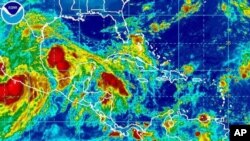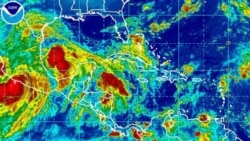Building on a 30-year relationship, top officials from the National Oceanic and Atmospheric Administration, or NOAA, and the European Organization for the Exploitation of Meteorological Satellites (EUMETSAT) recently signed a long-term cooperative agreement, ensuring continued space-based weather, water and climate monitoring.
At a ceremony at the European Union (EU) Delegation in Washington, D.C. on August 27th, Dr. Kathryn D. Sullivan, NOAA acting administrator and Alain Ratier, EUMETSAT’s director general, signed the agreement. They were joined by Dr. Francois Rivasseau, deputy chief of mission, EU Delegation to the United States.
“The need for environmental intelligence has never been stronger. This partnership with our EUMETSAT colleagues allows us to continue collecting and sharing vital space-based observations, resulting in a better understanding of our global environment,” Sullivan said.
Director General Ratier added, “The partnership between EUMETSAT and NOAA has continuously developed over the last 30 years and taken a strategic dimension, bringing substantial benefits to Europe, the USA and the worldwide user communities. Today the partnership covers back-up arrangements and data exchange for geostationary satellites and full sharing of low Earth orbit satellite systems, with the Initial Joint Polar System and the Jason series. With this agreement, we have established a policy framework to further develop our cooperation into the next decades.”
Key successes of the NOAA-EUMETSAT partnership include a joint polar satellite system operated by NOAA and EUMETSAT. Both agencies share all the data, which form the backbone of all medium range weather forecasts in the United States and Europe and make up the majority of the data used by the U.S. weather model (GFS) and the major European weather model (ECMWF).
NOAA instruments fly onboard the EUMETSAT satellites, and EUMETSAT instruments are on the NOAA spacecraft, providing cost savings and more uniform datasets for meteorologists and scientists across continents.
NOAA and EUMETSAT also exchange data from geostationary satellites, and have a back-up agreement in place for data sharing should either agency’s spacecraft experience trouble.
The partnership also extends to the Jason-2 ocean surface topography mission that has been crucial to improvements in weather modeling and tropical storm intensification forecasting, and is supporting the EU-led Copernicus Earth Observation program with data from the Suomi NPP satellite.
The United States is proud to work with its European partners to improve weather and climate change monitoring – information that will be benefit people everywhere in the world.
At a ceremony at the European Union (EU) Delegation in Washington, D.C. on August 27th, Dr. Kathryn D. Sullivan, NOAA acting administrator and Alain Ratier, EUMETSAT’s director general, signed the agreement. They were joined by Dr. Francois Rivasseau, deputy chief of mission, EU Delegation to the United States.
“The need for environmental intelligence has never been stronger. This partnership with our EUMETSAT colleagues allows us to continue collecting and sharing vital space-based observations, resulting in a better understanding of our global environment,” Sullivan said.
Director General Ratier added, “The partnership between EUMETSAT and NOAA has continuously developed over the last 30 years and taken a strategic dimension, bringing substantial benefits to Europe, the USA and the worldwide user communities. Today the partnership covers back-up arrangements and data exchange for geostationary satellites and full sharing of low Earth orbit satellite systems, with the Initial Joint Polar System and the Jason series. With this agreement, we have established a policy framework to further develop our cooperation into the next decades.”
Key successes of the NOAA-EUMETSAT partnership include a joint polar satellite system operated by NOAA and EUMETSAT. Both agencies share all the data, which form the backbone of all medium range weather forecasts in the United States and Europe and make up the majority of the data used by the U.S. weather model (GFS) and the major European weather model (ECMWF).
NOAA instruments fly onboard the EUMETSAT satellites, and EUMETSAT instruments are on the NOAA spacecraft, providing cost savings and more uniform datasets for meteorologists and scientists across continents.
NOAA and EUMETSAT also exchange data from geostationary satellites, and have a back-up agreement in place for data sharing should either agency’s spacecraft experience trouble.
The partnership also extends to the Jason-2 ocean surface topography mission that has been crucial to improvements in weather modeling and tropical storm intensification forecasting, and is supporting the EU-led Copernicus Earth Observation program with data from the Suomi NPP satellite.
The United States is proud to work with its European partners to improve weather and climate change monitoring – information that will be benefit people everywhere in the world.
















